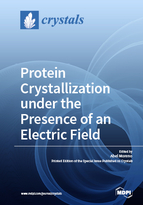Protein Crystallization under the Presence of an Electric Field
A special issue of Crystals (ISSN 2073-4352). This special issue belongs to the section "Biomolecular Crystals".
Deadline for manuscript submissions: closed (18 December 2017) | Viewed by 39025
Special Issue Editor
Interests: protein crystals; biocrystals; crystal growth; protein crystallography; crystal chemistry; biomineralization; biomimetics; biological macromolecules
Special Issues, Collections and Topics in MDPI journals
Special Issue Information
Dear Colleagues,
Nowadays, the use of electrically-assisted protein crystallization methods by using direct current (DC) or alternating current (AC), has revealed that, on average, crystals grow better in crystal quality and oriented to the cathode (when the protein molecule was positively charged), compared to the crystals grown on the anode (which is a negatively charged protein molecule). These electro-assisted crystallization techniques also enable the growth of protein crystals, as a function of temperature, under the influence of DC or AC electric fields. It has also permitted the isolation of protein polymorphs, as published elsewhere. According to recent publications, AC current could affect not only the number of crystals, but also their size, depending on its frequency. Up to now, the trend in crystal growth for protein models studied is as follows: The higher the AC the higher the number of crystals; in the near future this can be applicable to the free electron lasers (XFEL) experiments for solving complicated protein structures using the fourth generation of synchrotrons all over the world. There have been a significant number of publications focused on this topic recently, which is why the thematic issue in “Protein Crystallization under the Presence of an Electric Field” for the Crystals journal (ISSN 2073-4352, https://www.mdpi.com/journal/crystals) will be published soon. We encourage all specialists and experts on this topic to submit original contributions to this journal, and to the thematic issue for consideration and publication.
Prof. Dr. Abel Moreno
Guest Editor
Manuscript Submission Information
Manuscripts should be submitted online at www.mdpi.com by registering and logging in to this website. Once you are registered, click here to go to the submission form. Manuscripts can be submitted until the deadline. All submissions that pass pre-check are peer-reviewed. Accepted papers will be published continuously in the journal (as soon as accepted) and will be listed together on the special issue website. Research articles, review articles as well as short communications are invited. For planned papers, a title and short abstract (about 100 words) can be sent to the Editorial Office for announcement on this website.
Submitted manuscripts should not have been published previously, nor be under consideration for publication elsewhere (except conference proceedings papers). All manuscripts are thoroughly refereed through a single-blind peer-review process. A guide for authors and other relevant information for submission of manuscripts is available on the Instructions for Authors page. Crystals is an international peer-reviewed open access monthly journal published by MDPI.
Please visit the Instructions for Authors page before submitting a manuscript. The Article Processing Charge (APC) for publication in this open access journal is 2600 CHF (Swiss Francs). Submitted papers should be well formatted and use good English. Authors may use MDPI's English editing service prior to publication or during author revisions.
Keywords
Electric Fields
Protein Electrocrystallization
Electrochemically-assisted Protein Crystallization
Crystal Growth under the Presence of Electric Currents (DC/AC)






